Urban Green Space Accessibility and Distribution Equity in an Arid Oasis City: Urumqi, China
Abstract
1. Introduction
2. Materials and Methods
2.1. Study Area
2.2. Data Sources
2.3. Method
2.3.1. The Two-Step Floating Catchment Area Method (2SFCA)
2.3.2. Lorenz Curve and Gini Coefficient
2.3.3. Location Quotient (LQ)
3. Results
3.1. Overall Changes in UGS
3.2. Spatial Distribution of UGS Accessibility
3.3. Social Equity of UGS Accessibility
3.4. Spatial Patterns of Social Equity
4. Discussion
4.1. Influences of UGS Policies
4.2. Local Context and Potential Limitations
4.3. Policy Implications of Sustainable UGS Development
4.4. Contributions and Limitations
5. Conclusions
Supplementary Materials
Author Contributions
Funding
Acknowledgments
Conflicts of Interest
References
- Stessens, P.; Khan, A.Z.; Huysmans, M.; Canters, F. Analysing urban green space accessibility and quality: A GIS-based model as spatial decision support for urban ecosystem services in Brussels. Ecosyst. Serv. 2017, 28, 328–340. [Google Scholar] [CrossRef]
- World Health Organization. Urban Green Spaces and Health. A Review of Evidence; WHO Regional Office for Europe: Copenhagen, Denmark, 2016. [Google Scholar]
- Xiao, Y.; Wang, Z.; Li, Z.; Tang, Z. An assessment of urban park access in Shanghai—Implications for the social equity in urban China. Landsc. Urban Plan. 2017, 157, 383–393. [Google Scholar] [CrossRef]
- Wu, J.S.; Si, M.L.; Li, W.F. Spatial equity analysis of urban green space from the perspective of balance between supply and demand: A case study of Futian District, Shenzhen, China. Chin. J. Appl. Ecol. 2016, 27, 2831–2838. [Google Scholar]
- Fan, P.; Chen, J.; John, R. Urban landscape and environmental change during the economic transition on the Mongolian Plateau: Hohhot and Ulaanbaatar. Environ. Res. 2016, 144, 96–112. [Google Scholar] [CrossRef]
- United Nations. Sustainable Development Goals. Available online: https://www.un.org/sustainabledevelopment/zh/(2015) (accessed on 20 January 2020).
- McCormack, G.R.; Rock, M.; Toohey, A.M.; Hignell, D. Characteristics of urban parks associated with park use and physical activity: A review of qualitative research. Health Place 2010, 16, 712–726. [Google Scholar] [CrossRef]
- La Rosa, D. Accessibility to green spaces: GIS based indicators for sustainable planning in a dense urban context. Ecol. Indic. 2013, 11, 1742–1755. [Google Scholar] [CrossRef]
- Kabisch, N.; Haase, D. Green justice or just green? Provision of urban green spaces in Berlin, Germany. Landsc. Urban Plan. 2014, 122, 129–139. [Google Scholar] [CrossRef]
- Comber, A.; Brunsdon, C.; Green, E. Using a GIS-based network analysis to determine urban green space accessibility for different ethnic and religious groups. Landsc. Urban Plan. 2008, 86, 103–114. [Google Scholar] [CrossRef]
- Rojas, C.; Páez, A.; Barbosa, O.; Carrasco, J. Accessibility to urban green spaces in Chilean cities using adaptive thresholds. J. Transp. Geogr. 2016, 57, 227–240. [Google Scholar] [CrossRef]
- Wan, N.; Zou, B.; Sternberg, T. A three-step floating catchment area method for analyzing spatial access to health services. Int. J. Geogr. Inf. Sci. 2012, 26, 1073–1089. [Google Scholar] [CrossRef]
- Sallis, J.F.; Glanz, K. The Role of Built Environments in Physical Activity, Eating, and Obesity in Childhood. Future Child. 2006, 16, 89–108. [Google Scholar] [CrossRef]
- Bachi, L.; Ribeiro, S.C.; Hermes, J.; Saadi, A. Cultural Ecosystem Services (CES) in landscapes with a tourist vocation: Mapping and modeling the physical landscape components that bring benefits to people in a mountain tourist destination in southeastern Brazil. Tour. Manag. 2020, 77, 104–117. [Google Scholar] [CrossRef]
- Rigolon, A. A complex landscape of inequity in access to urban parks: A literature review. Landsc. Urban Plan. 2016, 153, 160–169. [Google Scholar] [CrossRef]
- Feng, S.; Chen, L.; Sun, R.; Feng, Z.; Li, J.; Khan, M.S.; Jing, Y. The Distribution and Accessibility of Urban Parks in Beijing, China: Implications of Social Equity. Int. J. Environ. Res. Public Health 2019, 16, 4894. [Google Scholar] [CrossRef] [PubMed]
- Park, Y.J.; Guldmann, J.M. Understanding disparities in community green accessibility under alternative green measures: A metropolitan-wide analysis of Columbus, Ohio, and Atlanta, Georgia. Landsc. Urban Plan. 2020, 200, 11–24. [Google Scholar] [CrossRef]
- Hamil, P.; Eller, J.K. Locating the green space paradox: A study of gentrification and public green space accessibility in Philadelphia, Pennsylvania. Landsc. Urban Plan. 2020, 195, 103–114. [Google Scholar] [CrossRef]
- Ward Thompson, C.; Roe, J.; Aspinall, P. Woodland improvements in deprived urban communities: What impact do they have on people’s activities and quality of life? Landsc. Urban Plan. 2013, 118, 79–89. [Google Scholar] [CrossRef]
- Schipperijn, J.; Stigsdotter, U.K.; Randrup, T.B.; Troelsen, J. Influences on the use of urban green space—A case study in Odense, Denmark. Urban For. Urban Green. 2010, 9, 25–32. [Google Scholar] [CrossRef]
- Xu, C.; Haase, D.; Pribadi, D.O.; Pauleit, S. Spatial variation of green space equity and its relation with urban dynamics: A case study in the region of Munich. Ecol Indic. 2018, 93, 512–523. [Google Scholar] [CrossRef]
- Wang, J.; Xu, C.; Pauleit, S.; Kindler, A.; Banzhaf, E. Spatial patterns of urban green infrastructure for equity: A novel exploration. J. Clean. Prod. 2019, 117, 858–871. [Google Scholar] [CrossRef]
- Tan, P.Y.; Wang, J.; Sia, A. Perspectives on five decades of the urban greening of Singapore. Cities 2013, 32, 24–32. [Google Scholar] [CrossRef]
- Wu, F.; Xu, J.; Yeh, A.G.O. Urban Development in Post-Reform China: State, Market, and Space; Routledge Press: London, UK, 2006. [Google Scholar]
- Urumqi Statistic Bureau. Urumqi Statistical Yearbook; China Statistical Press: Beijing, China, 2017.
- Ye, W.Y.; Yin, L.K.; Oian, Y. Study on plant community types and species diversity of main barren hill in Urumqi. J. Xinjiang Agric. Univ. 2015, 28, 44–48. [Google Scholar]
- Urumqi Statistic Bureau. Urumqi Statistical Yearbook; China Statistical Press: Beijing, China, 2014.
- Van Herzele, A.; Wiedemann, T. A monitoring tool for the provision of accessible and attractive urban green spaces. Landsc. Urban Plan. 2003, 63, 109–126. [Google Scholar] [CrossRef]
- Kong, F.; Nakagoshi, N. Spatial-temporal gradient analysis of urban green spaces in Jinan, China. Landsc. Urban Plan. 2006, 78, 147–164. [Google Scholar] [CrossRef]
- Ye, C.D.; Hu, L.; Li, M. Urban green space accessibility changes in a high-density city: A case study of Macau from 2010 to 2015. J. Transp. Geogr. 2018, 66, 106–115. [Google Scholar] [CrossRef]
- Luo, W. Using a GIS-based floating catchment method to assess areas with shortage of physicians. Health Place 2004, 10, 1–11. [Google Scholar] [CrossRef]
- Dai, D. Racial/ethnic and socioeconomic disparities in urban green space accessibility: Where to intervene? Landsc. Urban Plan. 2011, 102, 234–244. [Google Scholar] [CrossRef]
- Wang, A.; Wang, H.; Chan, E.H.W. The incompatibility in urban green space provision: An agent-based comparative study. J. Clean. Prod. 2020, 253, 120–127. [Google Scholar] [CrossRef]
- Lorenz, M.O. Methods of Measuring the Concentration of Wealth. Publ. Am. Stat. Assoc. 1905, 9, 209. [Google Scholar] [CrossRef]
- Delbosc, A.; Currie, G. Using Lorenz curves to assess public transport equity. J. Transp. Geogr. 2011, 19, 1252–1259. [Google Scholar] [CrossRef]
- Isserman, A.M. The Location Quotient Approach to Estimating Regional Economic Impacts. J. Am. Inst. Plan. 1977, 43, 33–41. [Google Scholar] [CrossRef]
- Urumqi Forestry Bureau. Urban Green Space System Planning of Urumqi; Urumqi Forestry Bureau: Urumqi, China, 2014. [Google Scholar]
- Xing, L.; Liu, Y.; Liu, X.; Wei, X.; Mao, Y. Spatio-temporal disparity between demand and supply of park green space service in urban area of Wuhan from 2000 to 2014. Habitat. Int. 2018, 71, 49–59. [Google Scholar] [CrossRef]
- Tian, Y.; Jim, C.Y.; Wang, H. Assessing the landscape and ecological quality of urban green spaces in a compact city. Landsc. Urban Plan. 2014, 121, 97–108. [Google Scholar] [CrossRef]
- Xinjiang Water Resources Bureau. Xinjiang Water Resources Bulletin; Xinjiang Water Resources Bureau: Xinjiang, China, 2013. [Google Scholar]
- Wang, L.; Liu, Y.; Sun, C.; Liu, Y. Accessibility impact of the present and future high-speed rail network: A case study of Jiangsu Province, China. J. Transp. Geogr. 2016, 54, 161–172. [Google Scholar] [CrossRef]
- Guzman, L.A.; Oviedo, D.; Rivera, C. Assessing equity in transport accessibility to work and study: The Bogotá region. J. Transp. Geogr. 2017, 58, 236–246. [Google Scholar] [CrossRef]
- Gu, X.; Li, Q.; Chand, S. Factors influencing residents’ access to and use of country parks in Shanghai, China. Cities 2020, 97, 102501. [Google Scholar] [CrossRef]
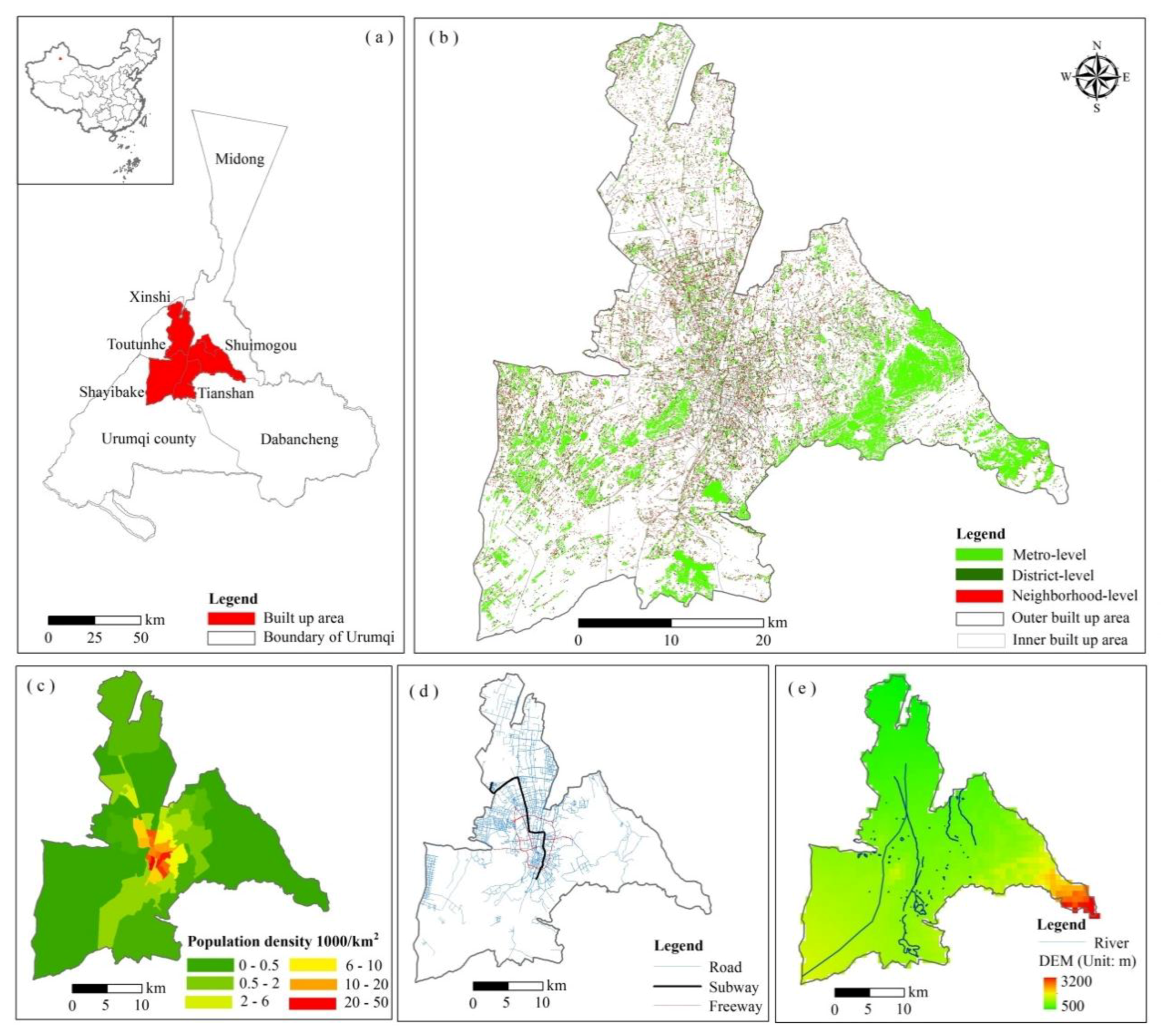
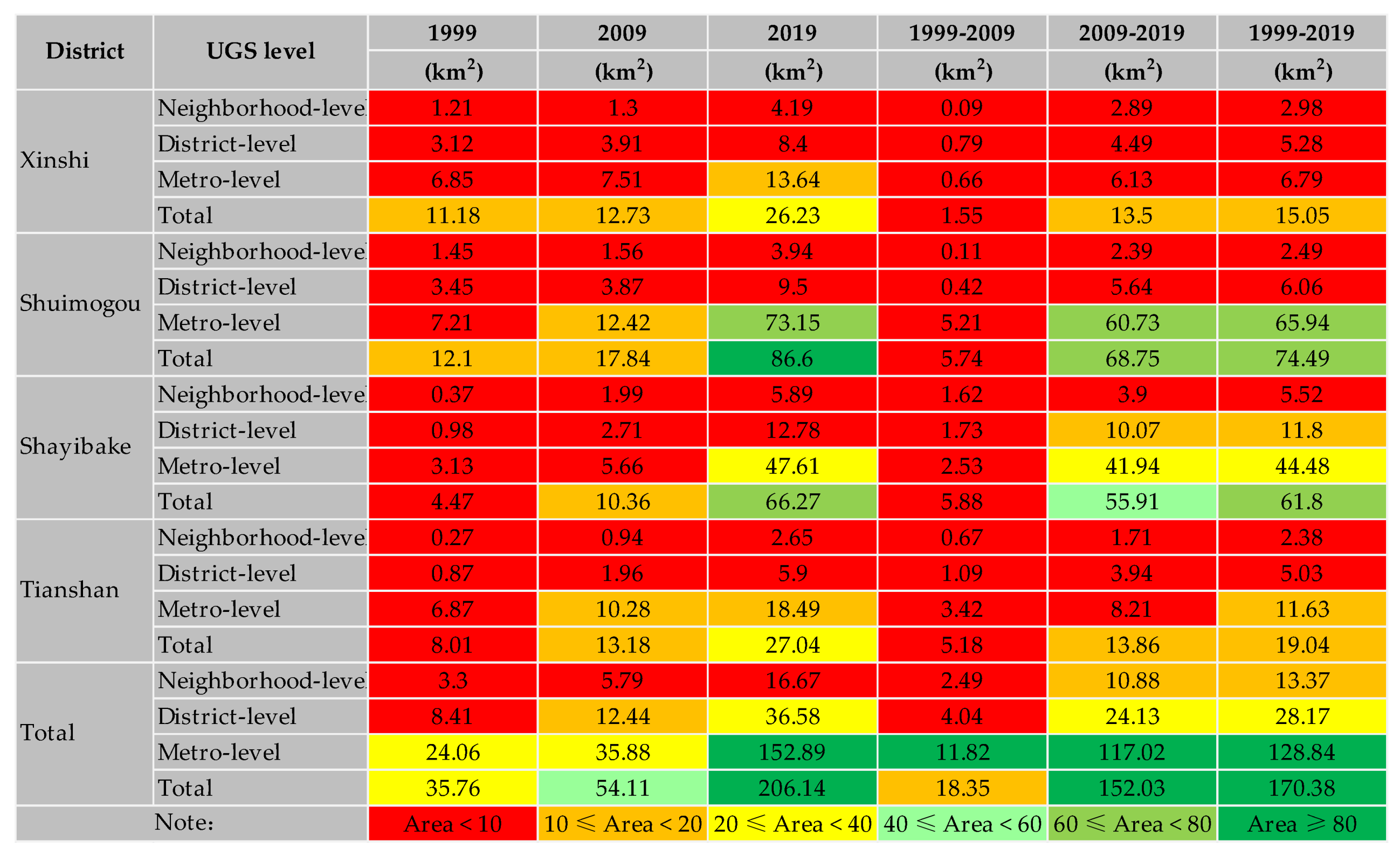
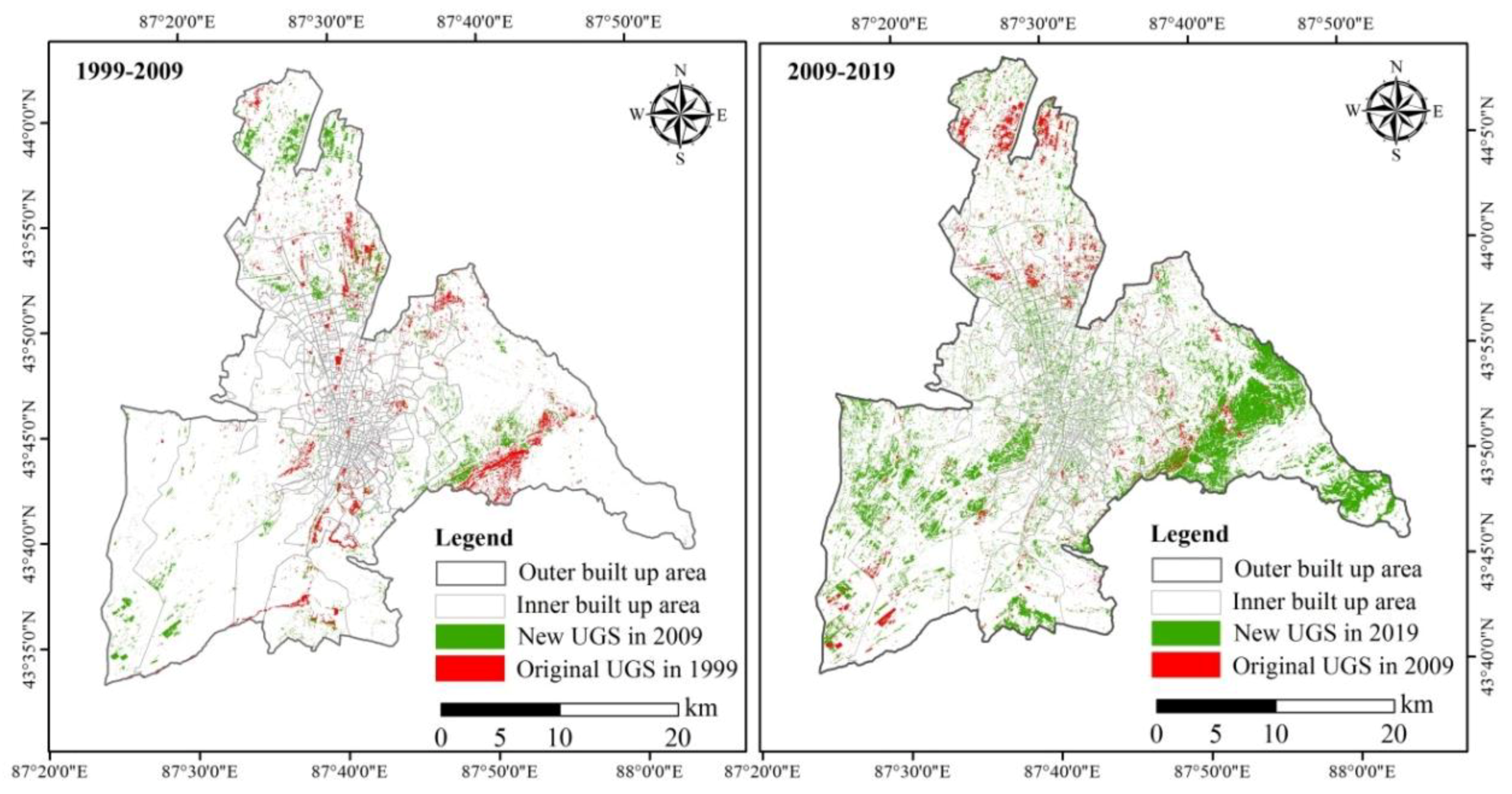
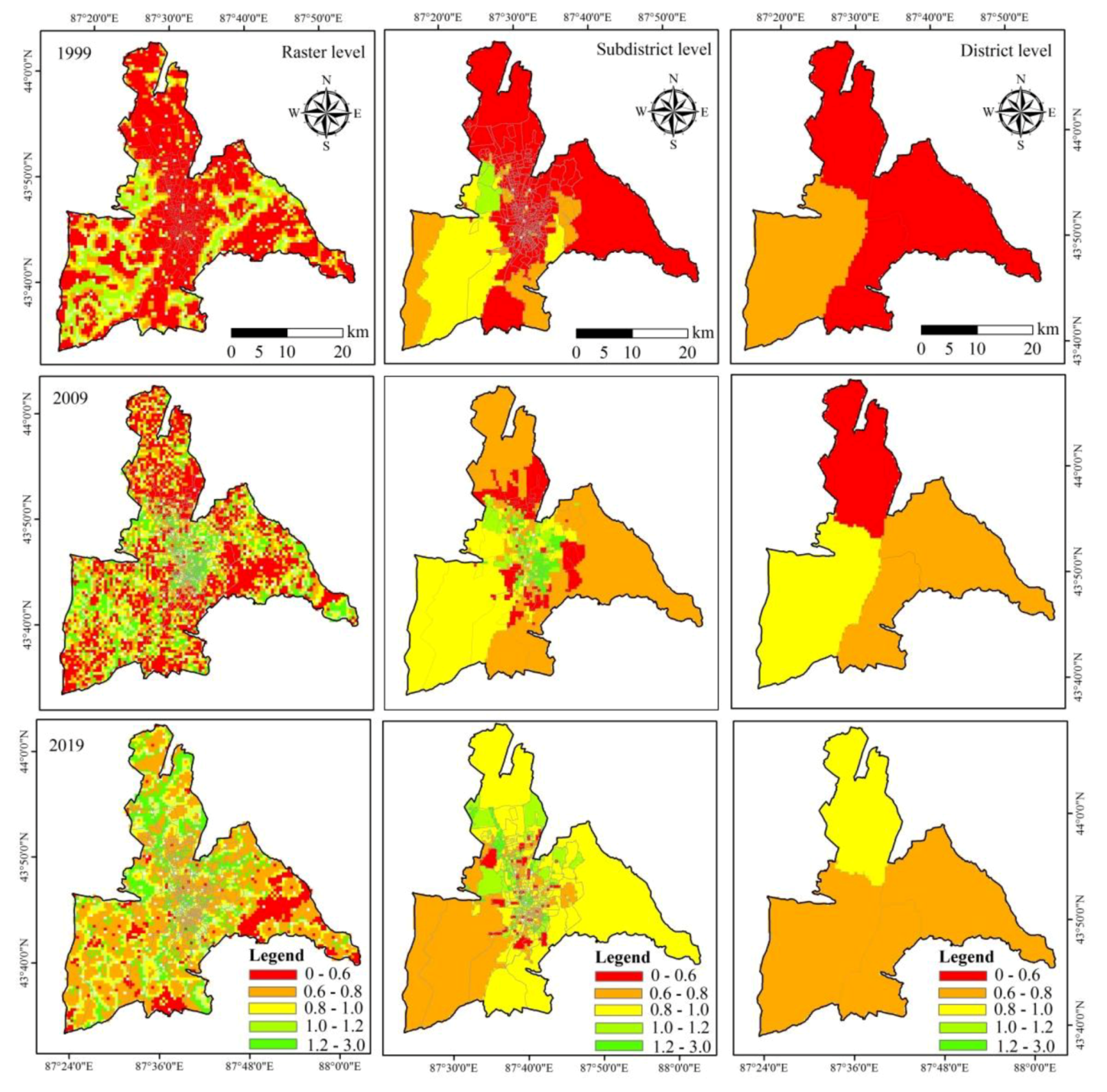
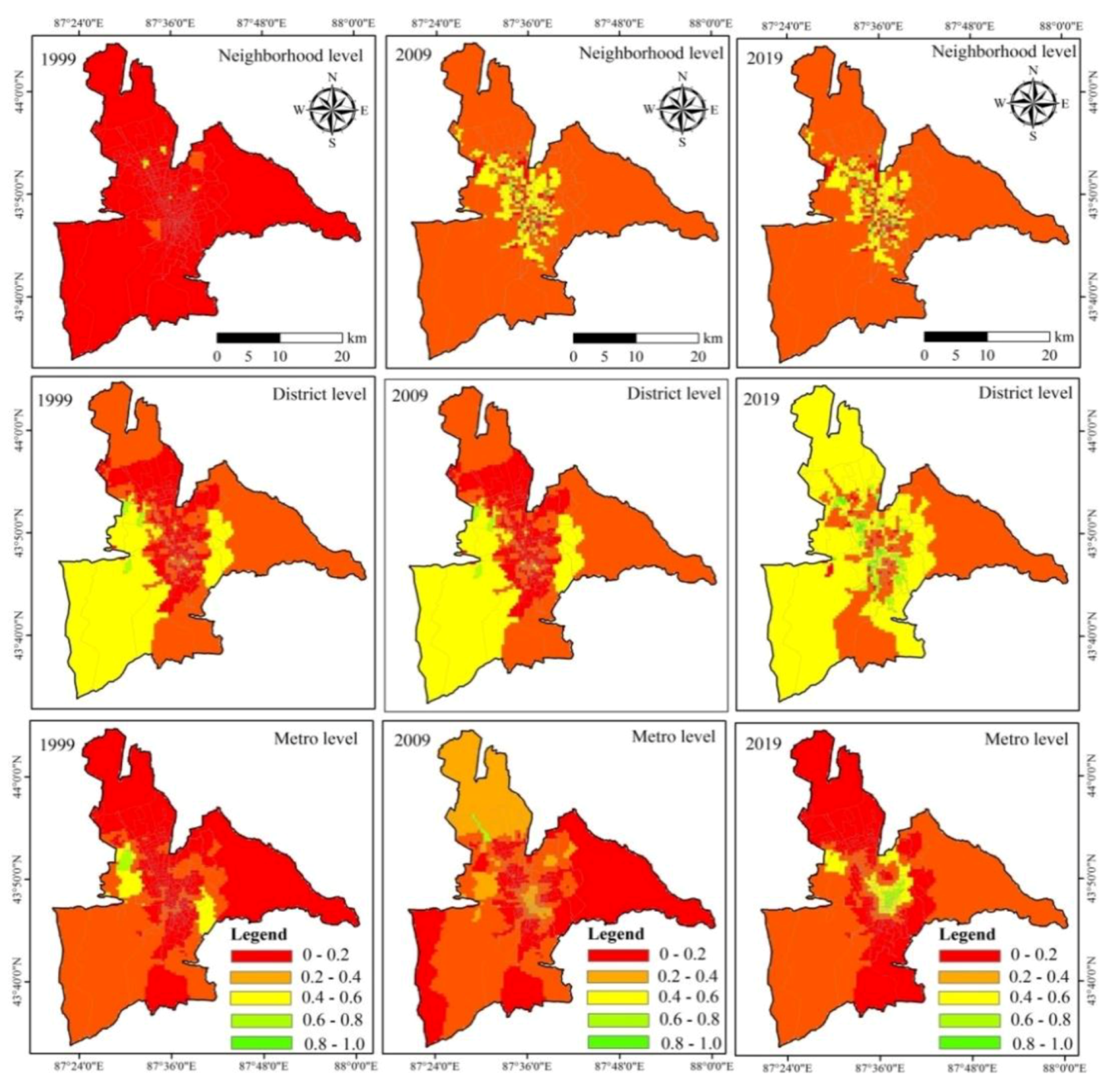
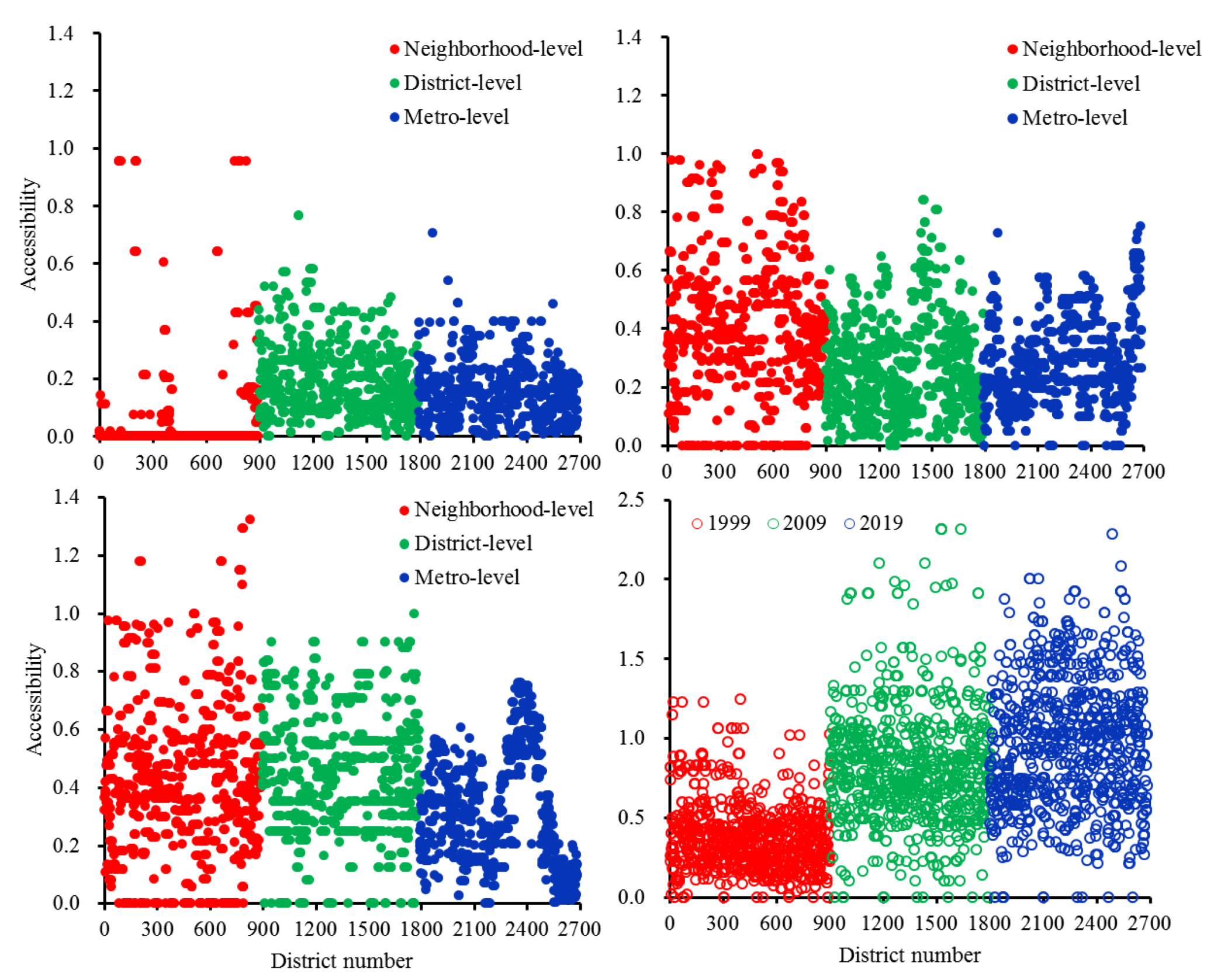
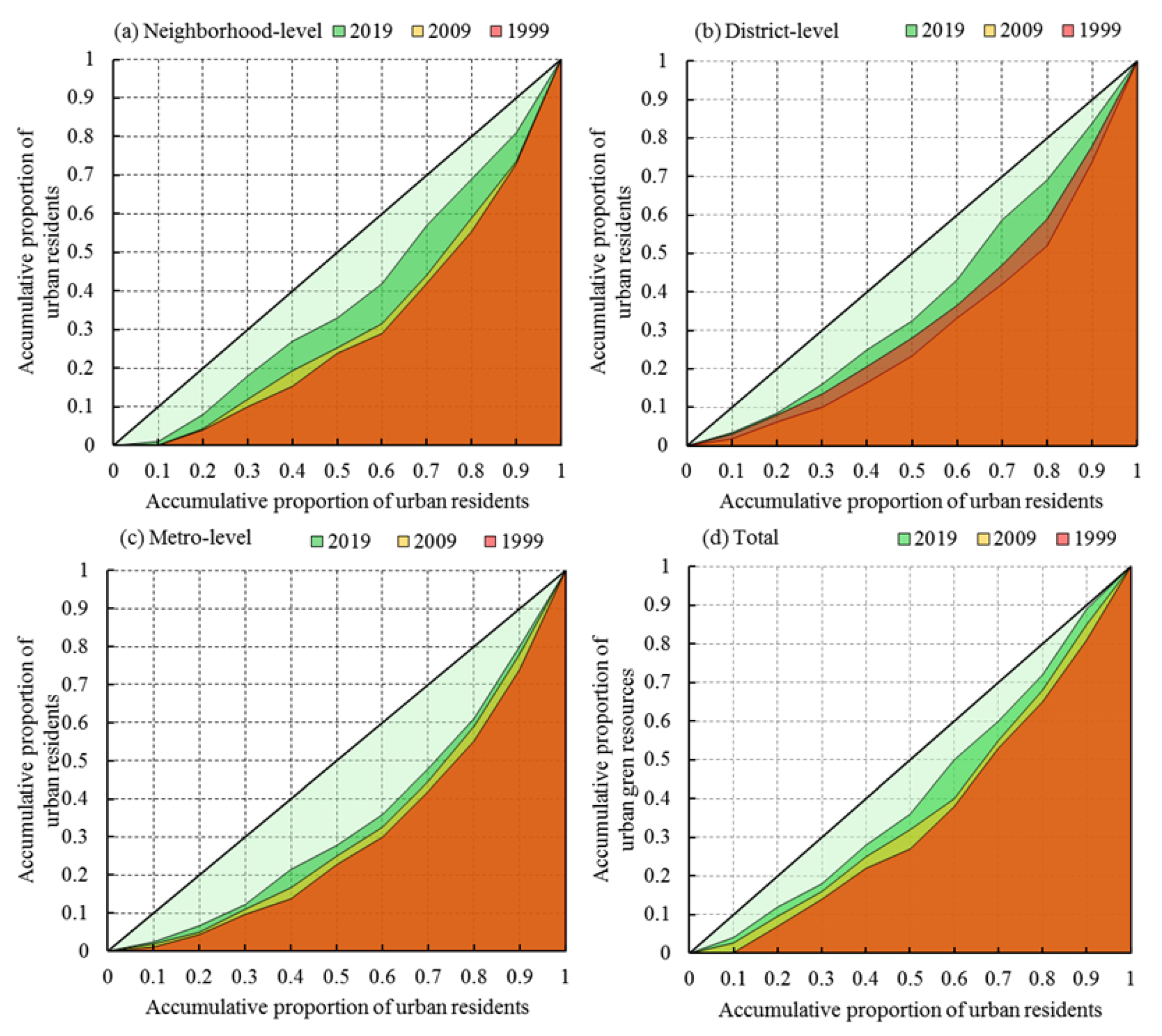
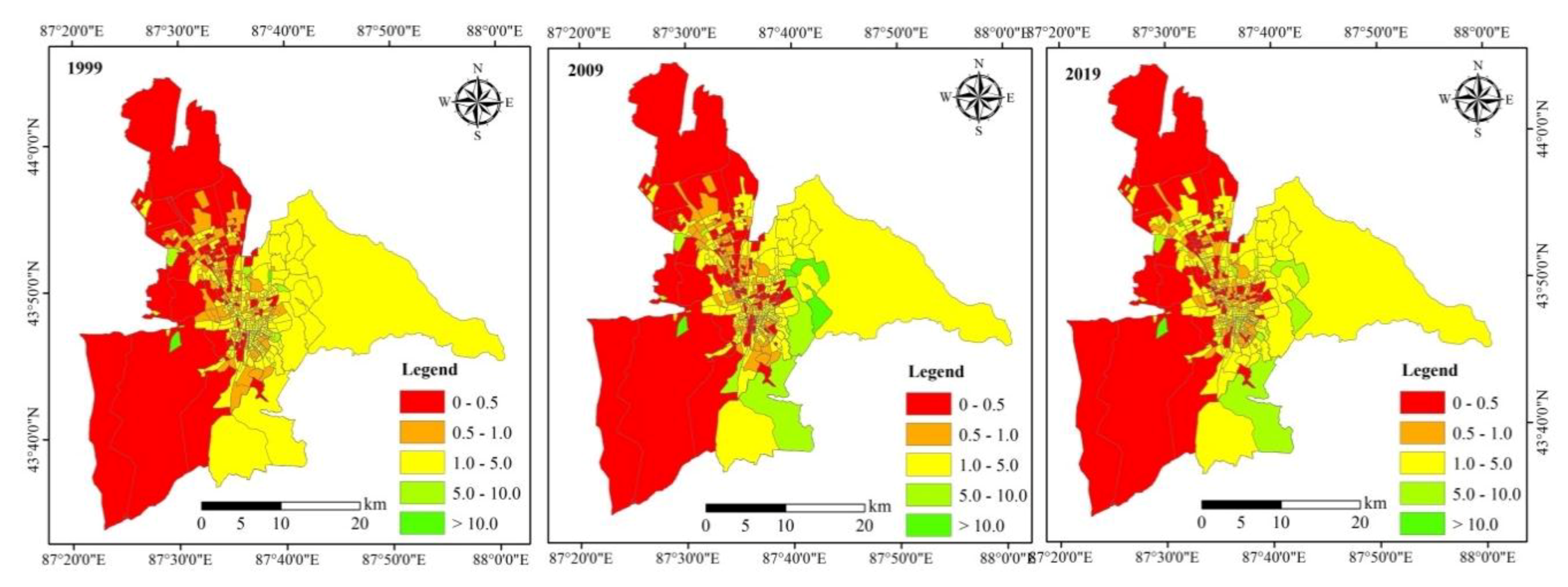
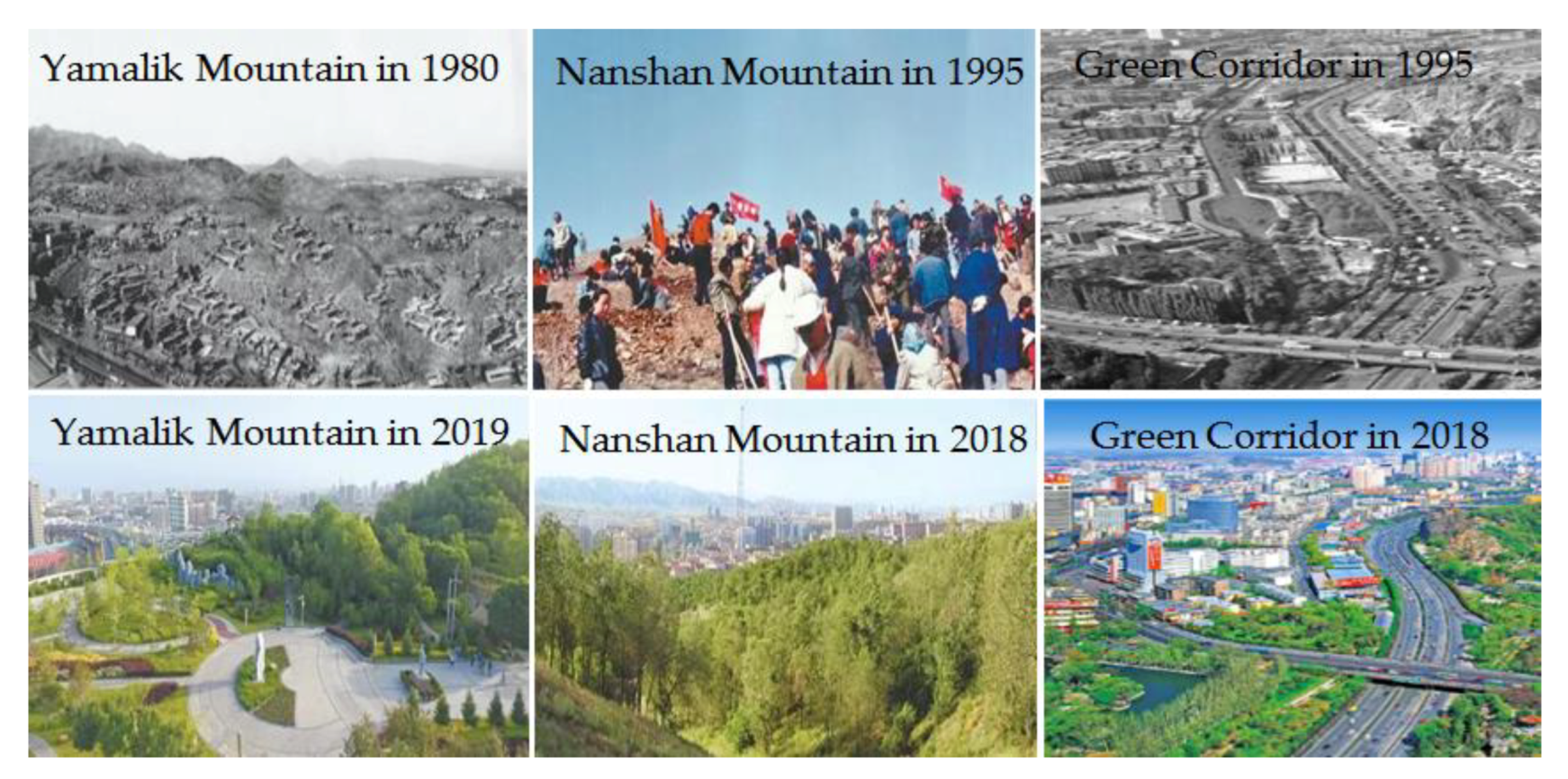
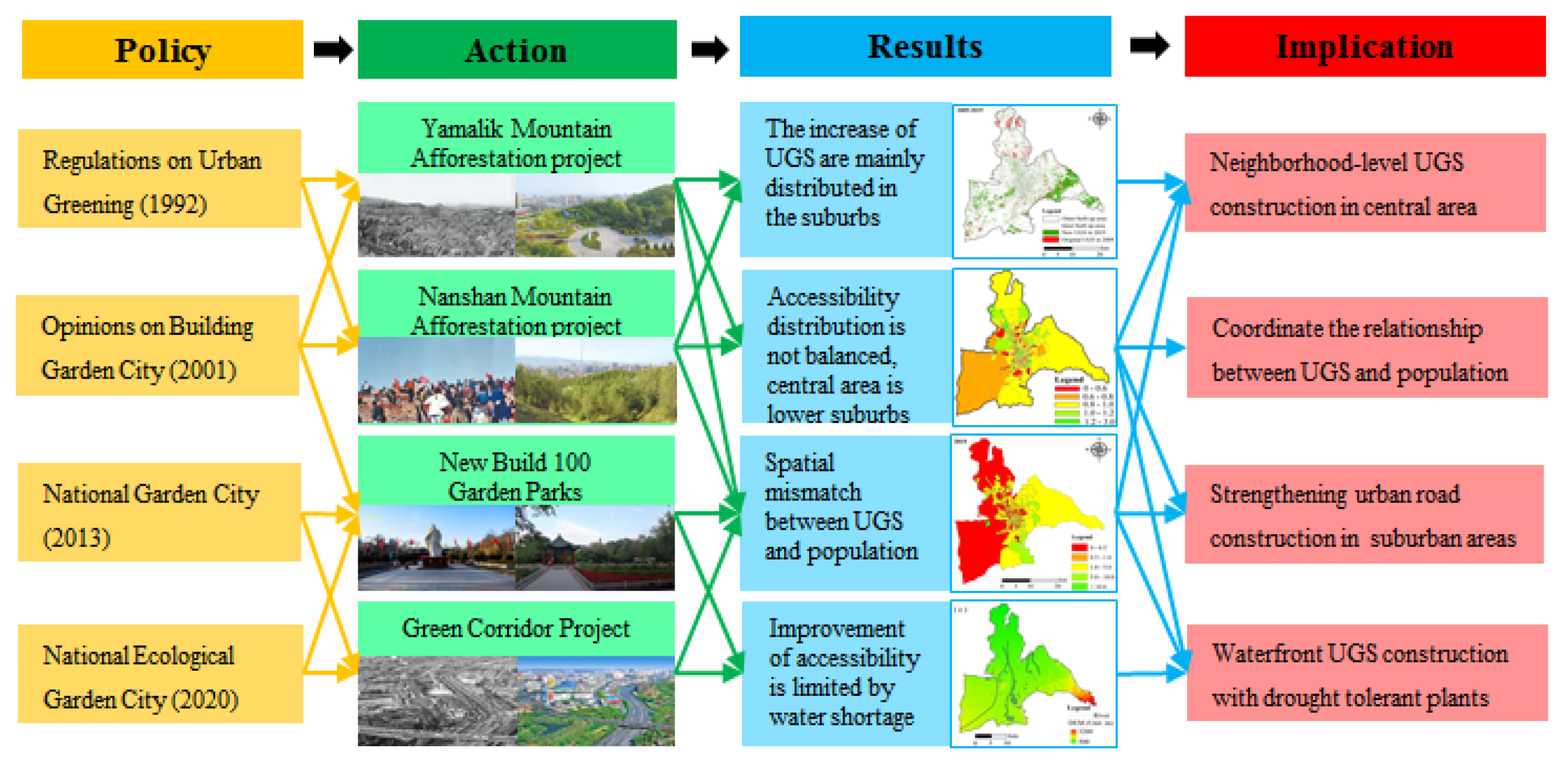
| Stages | Policy and Target | Action and Achievement |
|---|---|---|
| First stage (1992–2000) | Regulations on Urban Greening (1992); | Afforestation project of Yamalik Mountain and Nanshan Mountain; |
| The per capita UGS and UGS coverage rate should be more than 5 m2 and 30% in 2000. | UGS coverage rate had reached 23.3%, with 5.5 m2 of public green space per capita in 1999. | |
| Second stage (2001–2010) | Opinions on Urumqi Garden City Building (2001); | Urumqi has added 100 new garden parks; |
| Built Regional Garden City of Autonomous Region Xinjiang (2010). | Urumqi has established a garden city in 2010. | |
| Third stage (2011–2020) | Opinions on Urumqi Garden City Building (2001); | Green Corridor Project of River Beach; |
| Build National Garden City by 2013 and National Ecological Garden City by 2020. | UGS coverage rate in built-up areas was 35.35% and successfully established National Garden City in 2014. |
| UGS Categories | Definition | Images |
|---|---|---|
| Neighborhood level | Generally, for community use with basic facilities; area size is lower than 1000 m2. |  |
| District level | For special use with open spaces, plants and basic facilities; area size is more than 1000 m2. |  |
| Metro level | Open forest park, natural forests, and grasslands; area size is more than 3000 m2. |  |
| Neighborhood Level | 1999 | 2009 | 2019 | District Level | 1999 | 2009 | 2019 |
|---|---|---|---|---|---|---|---|
| 1999 | 1 | 0.056 | 0.036 * | 1999 | 1 | 0.083 | 0.040 * |
| 2009 | 1 | 0.040 * | 2009 | 1 | 0.053 | ||
| 2019 | 1 | 2019 | 1 | ||||
| Metro Level | 1999 | 2009 | 2019 | 2019 Year | Neighborhood Level | District Level | Metro Level |
| 1999 | 1 | 0.112 | 0.106 | Neighborhood level | 1 | 0.07 | 0.028 * |
| 2009 | 1 | 0.163 | District level | 1 | 0.042 * | ||
| 2019 | 1 | Metro level | 1 |
| Area | 1999 | 2009 | 2019 | 1999–2009 | 2009–2019 | 1999–2019 |
|---|---|---|---|---|---|---|
| Xinshi | 0.612 | 0.635 | 0.926 | 0.023↑ | 0.291↑ | 0.314↑ |
| Shuimogou | 1.609 | 2.614 | 4.720 | 1.005↑ | 2.106↑ | 3.111↑ |
| Shayibake | 0.753 | 0.84 | 0.869 | 0.087↑ | 0.029↑ | 0.116↑ |
| Tianshan | 1.341 | 2.376 | 3.587 | 1.035↑ | 1.211↑ | 2.246↑ |
| Total | 1.079 | 1.616 | 2.526 | 0.538↑ | 0.909↑ | 1.447↑ |
© 2020 by the authors. Licensee MDPI, Basel, Switzerland. This article is an open access article distributed under the terms and conditions of the Creative Commons Attribution (CC BY) license (http://creativecommons.org/licenses/by/4.0/).
Share and Cite
Shi, L.; Halik, Ü.; Abliz, A.; Mamat, Z.; Welp, M. Urban Green Space Accessibility and Distribution Equity in an Arid Oasis City: Urumqi, China. Forests 2020, 11, 690. https://doi.org/10.3390/f11060690
Shi L, Halik Ü, Abliz A, Mamat Z, Welp M. Urban Green Space Accessibility and Distribution Equity in an Arid Oasis City: Urumqi, China. Forests. 2020; 11(6):690. https://doi.org/10.3390/f11060690
Chicago/Turabian StyleShi, Lei, Ümüt Halik, Abdulla Abliz, Zulpiya Mamat, and Martin Welp. 2020. "Urban Green Space Accessibility and Distribution Equity in an Arid Oasis City: Urumqi, China" Forests 11, no. 6: 690. https://doi.org/10.3390/f11060690
APA StyleShi, L., Halik, Ü., Abliz, A., Mamat, Z., & Welp, M. (2020). Urban Green Space Accessibility and Distribution Equity in an Arid Oasis City: Urumqi, China. Forests, 11(6), 690. https://doi.org/10.3390/f11060690








